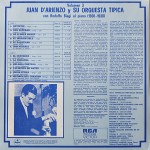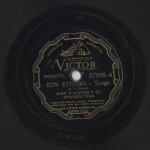On the 3rd of July 1936 the Juan D’Arienzo orchestra recorded the tango Don Esteban. Most reeditions, especially from the RCA Víctor company, for which the tango has been recorded in 1936, contain a different version as the one which can be found on the japanese CD-collection CTA (Club Tango Argentino), Juan D’Arienzo Vol. 2 CTA-302. This has been an ongoing discussion in tango newsgroups and found to be quite mysterious.
As Johan stressed it out in his article The Strange Case of Don and Mr. Esteban by comparing first the edition history of this tango through out the years and then analysing the tango itself, there might have been two takes during the recording session back on the 3rd of July 1936. This is his scheme with the differences between take 1 and 2 bar by bar:
I have found now by coincidence an original 78 rpm pressing of the 1936 recording (Victor record number 37955) and as a matter of fact there have been clearly 2 takes of this tango. The Victor Encyclopedic Discography by the University of California contains a glossary which explains the term take:
Take numbers can usually be found on Victor 78-rpm discs on the record surface area just outside the record label, in the nine o’clock position. First takes are usually not indicated; there is no number in that area when a record derives from take 1.
The 78 rpm record in my collection has a take number 2 in the nine o’clock position as you can see on the following pictures:
 Now the question is which one is the first and which one the second take? A question which remains so fare without answers. In a recent discussion a friend said: “The CTA-version for me is jazzier because of the first piano solo which is played sycopated while the other is straight marcato. It sounds to me more like Biagi’s idea, and I can imagine that D’Arienzo preferred the straighter one and gave Biagi two more solos instead.”
Now the question is which one is the first and which one the second take? A question which remains so fare without answers. In a recent discussion a friend said: “The CTA-version for me is jazzier because of the first piano solo which is played sycopated while the other is straight marcato. It sounds to me more like Biagi’s idea, and I can imagine that D’Arienzo preferred the straighter one and gave Biagi two more solos instead.”
On the B-side of the record number 37955 is the vals No llores madre and to disambigue it has a little “1”, as for take one in the nine o’clock position right beside the label.

 To keep it short, the version by CTA is the second take, and my 78 rpm too. Now we can speculate what happened that day on the 3rd of July 1936. Maybe D’Arienzo was late and the orchestra recorded without him, possibly led by Biagi on the piano. The wax was already galvanised, when all of a sudden D’Arienzo rushed into the studio and ordered for a second take, lowering the part of Biagi as the two piano solos are now missing. By the way, in this scenario the jazzman would have been D’Arienzo. But most probably they were all present that day and just arrived at two different versions, maybe one more in the sense of Biagi and one more in D’Arienzo’s style. Then RCA Víctor said that they would send out both on the market and let the music lover decide which version they prefer. As D’Arienzo records sold like hot cakes, this seems to be the most plausible scenario 🙂 And it could be that take 1 has been intentionally released exclusively in Uruguay and that take 2 was intented for the domestic market. That would be an even more plausible explaination for the existence of the two Don Esteban versions (In this case the two piano solos could maybe be seen as a concession to what D’Arienzo thought would better meet the Uruguayan taste).
To keep it short, the version by CTA is the second take, and my 78 rpm too. Now we can speculate what happened that day on the 3rd of July 1936. Maybe D’Arienzo was late and the orchestra recorded without him, possibly led by Biagi on the piano. The wax was already galvanised, when all of a sudden D’Arienzo rushed into the studio and ordered for a second take, lowering the part of Biagi as the two piano solos are now missing. By the way, in this scenario the jazzman would have been D’Arienzo. But most probably they were all present that day and just arrived at two different versions, maybe one more in the sense of Biagi and one more in D’Arienzo’s style. Then RCA Víctor said that they would send out both on the market and let the music lover decide which version they prefer. As D’Arienzo records sold like hot cakes, this seems to be the most plausible scenario 🙂 And it could be that take 1 has been intentionally released exclusively in Uruguay and that take 2 was intented for the domestic market. That would be an even more plausible explaination for the existence of the two Don Esteban versions (In this case the two piano solos could maybe be seen as a concession to what D’Arienzo thought would better meet the Uruguayan taste).
Now, on the other side, it would be interesting to find an Argentinian 78 rpm containing the first take to contradict this theory. (From what I was able to check with other collectors so fare only take 2 exists from RCA Víctor Argentina). And also, as you might know the first take has been handed down by RCA Víctor exclusively with a very strong echo (reverb effect). All CD versions, like from El Bandoneon and the Magenta version seem to be taken from that 1980 RCA Víctor LP. There is still no carefully restored version of this 1st take! I’m also wondering why CTA did not mention the “2” for second take on their CD, though it’s really evident when you have the 78 rpm record in your hands.
Check out the two versions, first the only reedition by RCA Víctor on the LP sampler Serie Tango De Ayer from 1980 (based on take 1) and then my restored version (based on take 2). Which one do you find jazzier?
- Juan D’Arienzo Don Esteban from the RCA Víctor LP (transfer 1980)
- Juan D’Arienzo Don Esteban from my 78 rpm record (transfer 04/11/2013)


